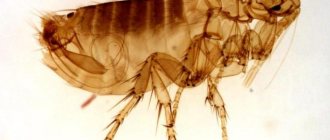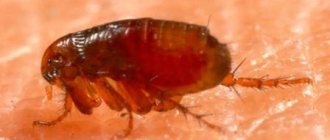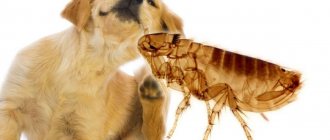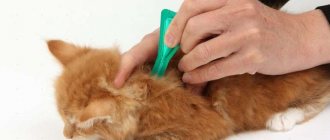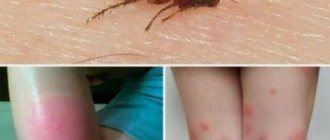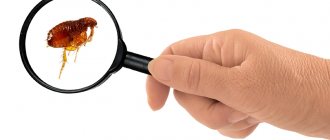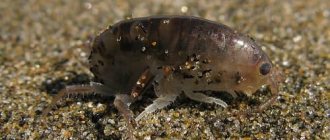What do we know about fleas?
The flea is a blood-sucking ectoparasite, characterized by its small size (on average 1-5 mm, but there are larger exceptions) and also its phenomenal jumping ability. The color of the chitinous exoskeleton of this jumper varies from classic brown to deep black.
The habitat of fleas is incredibly large. These small bloodsuckers can be found even in the snows of the Arctic.
Fleas are not picky in choosing a host. They are able to parasitize all warm-blooded creatures, especially cats and dogs due to their thick fur. They are not found only in fish and various amphibian-reptiles.
Since the community of warm-blooded animals is very diverse, including the class of birds, fleas for each species have some differences in appearance. But the fundamental signs are the same for everyone. Based on them, zoologists classified all flea families into one order.
Cleaning an apartment from fleas
Most often, fleas do not live on a pet, but hide in secluded corners of the apartment. Therefore, after treating the animal, it is necessary to treat the room. First, it is recommended to vacuum the cat's bedding, furniture, carpets, wash soft toys and linens, and do wet cleaning. After this, the room is treated with a composition against such parasites. This can be a concentrate for preparing a solution (Chlorpirimak, Biorin) or a spray (Kombat, Raptor).
You can treat your cat's bedding with insecticides. After all the actions, the room is ventilated and left for 2-3 days.
If this is not possible, you should treat areas where people will be with soapy water. If there are too many fleas, you need to seek help from an exterminator.
What fleas can bite humans?
Can fleas live on humans? A person does not have fur like cats, dogs, rodents, does not have plumage like birds, therefore, he cannot be a permanent host for fleas. These parasites cannot reproduce on human skin.
Most often, people suffer from bites from fleas whose permanent hosts are near them. Or from those species that live in the external environment.
Answering the main question of this article, we can safely say that cat fleas bite a person if there are too many of them and the cat is no longer enough for them. If you do not monitor the condition of your pet, fleas can breed in his fur and move into carpets, clothes and bite people. Fleas of other families, such as dog fleas, also do not lag behind in this matter.
Common types of fleas:
- canine;
- felines;
- chicken;
- rat;
- human.
By location:
- domestic;
- earthen;
- bedding;
- sandy.
How are parasites transmitted?
Fleas live everywhere. They are brought into living quarters by cats, dogs, and birds. They choose specific animals, although they easily change their owners if necessary.
Fleas that are on the body of animals also bite people, as they jump well in height: 50-60 cm. Fleas do not fly, but they infect people by jumping long distances. Able to survive in any extreme conditions. Due to the morphological structure of the body, it is not easy to see and crush them.
Flea bites: what they look like and why they are dangerous, read more in the article here.
Fleas:
- canines are transmitted from pet carriers;
- felines are brought in by cats and scatter around the room like fine dandruff;
- rats appear from rats living in garbage dumps and sewers.
Rat fleas are the most dangerous insects, carriers of infectious diseases (salmonellosis, cholera). They move between apartments, roam from one door to another or from house to house.
Why do fleas bite some people and not others?
It is not true. Fleas bite everyone, it’s just that people with thin skin, without excess fat, and when blood vessels are located close to the surface of the skin are “tastier” to them. They are also attracted to natural body odor. This is one of the reasons why, under the same conditions, adults do not have bite marks, but children do.
The second factor responsible for the presence of bite marks is sensitive, sensitized skin.
In the photo: cat flea bites on a person
People who have a severe allergic reaction to insect bites always have a painful reaction. This is not only a feeling of pain, itching, swelling of soft tissues at the site of the bite and next to it, but also a general malaise. Most often it is headache, fever, and sometimes shortness of breath.
People who are not prone to allergic reactions, and even with excess subcutaneous fat, may simply not notice or feel the bites of small bloodsuckers.
How to treat bites
Although the answer to the question of whether fleas live on humans is no, the danger posed by these jumping cat parasites can never be ruled out.
If bite marks are found, wash the affected part of the body with warm water and antiseptic soap and pat dry. Then apply an antiseptic solution to the skin, especially if the person has been severely bitten. We recommend:
- an aqueous solution of vinegar or citric acid;
- Calamine solution;
- Hydrocortisone ointment;
- Fenistil gel.
Calamine solution is a natural remedy. It has antiseptic properties, reduces inflammation, relieves itching, swelling and redness. It is suitable for children. Side effects are minimal.
Hydrocortisone is a hormonal drug that relieves itching and effectively fights inflammation. There are contraindications and side effects.
Fenistil gel is an antihistamine (anti-allergic) and analgesic for children over 1 month and adults, relieves itching and burning of the skin. It is based on dimethylene. There are side effects and contraindications.
Before using the above products, consult your doctor to avoid side effects and allergic reactions.
How dangerous are cat fleas for humans?
The most harmless harm that can be caused by a cat flea bite is bright spots from noticeably painful bites, scratching, after which traces may remain. If the bites are scratched, and various pyogenic microorganisms, such as streptococci, get into the open wounds, inflammation and suppuration occur.
But this is not the entire list of dangers. It is much worse to get any of the following infections from such a bite:
- anthrax;
- typhus;
- plague;
- infectious encephalitis;
- hepatitis and encephalitis viruses;
- some helminthiases.
It is curious that fleas that carry infections are not able to transmit the infection to their offspring, but they themselves will carry this infection until the last day, each time becoming a source of disease.
Features of parasitism
Insects feed on the blood of cats, but in their absence they can attack other animals and even humans. The oral apparatus of cat fleas has such a structure that it allows them to feed exclusively on blood. The parasite has a short proboscis, which is why when eating it takes a vertical position, and part of the body is located in the wound.
The flea makes several punctures with its proboscis. During the bite, saliva is injected into the wound, causing allergic reactions, dermatitis, papules, etc. in the animal.
When it is satisfied, it leaves the victim's body.
A kitten can become infected with pests from its mother. Flea parasitism causes severe itching in the animal. The cat begins to scratch its skin until it bleeds, which is why it becomes irritable. She may experience hair loss, quite intensely. Treatment of the pet is carried out using shampoos, collars, sprays, insecticides.
How to distinguish flea bites?
- Flea bites look like stars in small constellations - 2-3 next to each other, but there are no characteristic “paths” between them, as with scabies.
- In the first hours, the bite site resembles a large red swollen spot with a small pimple in the center, then after some time (from several hours to a day) the redness disappears and itching increases.
- The bite itself is accompanied by stabbing pain (like a hot needle) and a pronounced burning sensation.
- Bites are localized mainly on the legs and lower back. If we are talking about a sleeping person, then the arms, neck, and sometimes the upper chest suffer.
In general, flea bites are very similar to bedbug bites. The main difference between them is location.
Development cycle
Life cycle of a flea.
The life cycle of a flea has several stages:
- egg;
- larva;
- chrysalis;
- adult.
At temperatures of +18...+25°C, insects can reproduce all year round. At lower temperatures, the reproduction process stops. Females lay eggs in small groups. After 2 weeks, legless larvae begin to hatch.
In appearance they resemble worms. After 3 moults, the larvae transform into pupae, which are wrapped in a cocoon. This stage lasts 2-3 months. The pupa then develops into an adult.
What to do if you are bitten by a cat flea?
- Wash the bite site with clean water and soap or a disinfectant - chlorhexidine or peroxide, this will reduce the risk of infection and inflammation.
- Apply antipruritic ointment or cream to the affected area, such as Fenistil or Flucinar. A regular ice cube will also help relieve itching.
- If an allergy occurs, take an antihistamine and consult a doctor.
- Wait until the swelling, itching and redness subside. If inflammation begins, contact the clinic immediately.
Treatment of bites and control of parasites
Treatment will be required if the discomfort after the bite does not go away within several days or the pain becomes unbearable. The use of various agents depends on the characteristics of the human body and the symptoms of the lesion.
If itching occurs:
- treat the wound with soap and warm water, then wipe with alcohol or hydrogen peroxide;
- Apply an ice cube to the bite site.
You can also eliminate the burning sensation with calamine solution, sulfur ointment, or a weak solution of baking soda. If an allergy occurs, this condition should be treated with antihistamines - Diazolin or Suprastin, sedatives, and medications that reduce body temperature. A universal remedy that is used to treat bites is hydrocortisone ointment. Apply it to the wound immediately after the damage is detected.
When fleas appear in an apartment, you need to start fighting them immediately. First, it is necessary to cure the infected cat, and then treat the premises to protect the people living there.
Effective remedies for treating flea bites.
To eliminate fleas from an animal, special means are used:
- Drops on the withers – Advantage, Api-San, Lawyer, Frontline Spot on Cat, Bars. They are suitable for both adult pets and kittens. The drug contains an insecticide - methoprene or fipronil.
- Sprays – Bars, Frontline. They contain the same basic components as the drops, but they differ in the method of application. Valid for 1-2 months.
- Collars – Foresto, Bars, Beaphar. Such products are impregnated with insecticides, and the effect of their use lasts 2-3 months.
- Shampoos – Doctor ZOO, RolfClub, Bearhar Bio Shampoo. They are used as part of complex therapy. The preparations contain insecticides, as well as herbal, moisturizing and cleansing components.
After treatment, the animal cannot be bathed for 3 days.
Where can a cat get fleas?
A cat's fleas can come from anywhere. Sometimes it’s enough just to let him outside for a walk for a while - he will certainly return not only grimy and foul-smelling, but also with a handful of large adult and very hungry fleas.
The most common breeding grounds for these ectoparasites are:
- infected animals;
- mats, cat houses, beds that have already been used by infected animals;
- wild animals (mice, rats, moles, hedgehogs, foxes, badgers, etc.);
- livestock farms, especially fur farms and those where rabbits are bred;
- heavily infested with fleas rooms, basements;
- forest, fields, meadows, forested areas.
Causes of flea infestation in cats
A cat can catch fleas in several ways. The most common reasons:
- Fleas wait for their prey outside, hiding on the ground or clinging to the grass.
- They get into the house along with a person’s clothes and shoes.
- They enter houses through cracks in walls and floors (residents of the first floors are especially affected, since the basements of most houses are infested with various parasites).
- Fleas jump from one animal to another.
- Infection can occur when hunting rodents (Ctenocephalides felis does not feed on the blood of rats and mice, but can use them as “transport” and a place for laying eggs).
Kittens can get fleas from their mother
Prevention measures
To avoid dealing with fleas and prevent flea bites on yourself and your pet, you need to learn preventive measures and methods for removing fleas.
If we talk directly about cat fleas, they are very comfortable not only on cats. They also feel great close to their furry pets, and it doesn’t matter at all whether it’s a cozy apartment in a high-rise building or a hay barn in the village.
The first step is protecting your pets. There are a lot of proven means for this:
- insectoacaricidal shampoos;
- flea drops;
- pills;
- anti-flea collars.
It is important to remember that fleas are removed in conjunction with deworming. Detailed recommendations on this issue can be obtained from any veterinary clinic.
For current planned prevention, it is enough to treat your pet once every 3-6 months, depending on the drug chosen, lifestyle and place of permanent residence. Even a cat that doesn’t walk outside can pick up parasites, for example, from a neighbor’s pet or from a stairwell. You can bring flea larvae into your home on your shoes without knowing it, and then wonder where they came from.
The second stage of prevention is no less important. It applies to the treatment of places where pets are kept. For this purpose, a wide variety of products are also produced: repellent sprays, solutions, emulsions, liquid detergents.
Wash your cat's bedding and other favorite soft items that may contain flea eggs. If possible, steam them with a household steamer at maximum temperature and treat them with the purchased product. Wash all floors, disinfect bedspreads and carpets in the apartment.
Removing fleas on an animal
Cat fleas are dangerous for the cat itself. Look for external signs that your cat is infected with obligate parasites:
- restless behavior;
- poor sleep habits;
- refusal to eat;
- weight loss;
- constant scratching and biting in the same places;
- fever;
- refusal to play.
If you part the fur, you can see red bite marks on the skin and the parasites themselves. Fleas are most numerous on the front of the neck, behind the ears, in the armpits of the paws and on the stomach. In these areas, the skin is soft and the blood vessels are located close to each other.
Fleas on your pet's fur
Your pet may be at risk for parasites:
- allergic dermatitis;
- helminthiasis;
- physical deterioration;
- weight loss and muscle weakness;
- mycoplasmosis;
- fever;
- infection with fungal diseases;
- loss of six;
- anemia.
Get rid of fleas immediately. Wash the cat with soap and rinse with special shampoo or tar soap. Liquid and gel products are more convenient to use. Special baths are designed for pets and are safe.
Then apply a special anti-parasitic spray to the cat and apply drops to the withers. Medicines for cats and dogs are dosed depending on the weight of the animal. They are toxic and an overdose can harm your cat. Once applied to the skin, the product gradually spreads and penetrates the bloodstream, making it useless for fleas and ticks. It paralyzes blood-sucking parasites when they try to suck.
The cat must be bathed with a special product
The scent from the collar spreads through the fur and repels blood-sucking parasites. It acts not only on fleas, but also on all types of ticks, including ixodid ticks. The collar protects the cat from all parasites while walking. At the same time, treat the cat's bed or house, its toys and the rest of the apartment.
Consequences of flea bites
Do fleas bite a person if there is another warm-blooded animal nearby? Of course, parasites prefer a permanent “place of residence,” but when they urgently need a new portion of blood, they will not figure out where to get it from. Parasites will easily reward a new host with diseases such as anthrax, pseudotuberculosis, tularemia, typhus, and encephalitis. They are also carriers of meliodosis, myxomatosis, and brucellosis.
It is almost impossible to become infected in the home. Fleas on animals that do not roam in polluted areas are rarely sources of infection. But they can cause severe allergic reactions and itchy skin after a bite. As a result, the risk of scratching the wound and infection from the outside increases.
Interestingly, parasites are selective when searching for prey. Then why don't fleas bite everyone? The answer to this question lies in the evolutionary development of man. Blood group I is considered the most ancient. This is what most often interests parasites. You can often read on the Internet: “why do fleas bite me, but others don’t?” It's all about the composition of the blood, but if the flea is hungry and there is no suitable victim nearby, then representatives of other groups will also come along. In this sense, parasites are not picky. But why don’t earth fleas bite all people? It's all about preparation for working with the soil. If safety precautions are followed, fleas that bite people will not attack.
One of the terrible diseases carried by these insects is plague. When bitten by an infected rat - the main carrier of the plague bacillus - the bacterium begins to actively multiply in the insect's crop, preventing it from becoming saturated. Such a flea is constantly hungry, which forces it to look for new sources of food. The trouble is that this search for food results in the rapid infection of a large number of animals and people. The person himself becomes a source of infection, and he begins to develop plague pneumonia.
Top 5 most effective self-treatment products
- An aerosol like dichlorvos is the most popular and effective flea remedy. Before you start working, you need to put on a respirator mask. Children and pets must leave the premises. It is necessary to spray all baseboards, furniture, interior surfaces of cabinets, bedding, and clothing. After treatment, close windows and doors for several hours,
- Flea whitening is an inexpensive remedy for self-treatment of a room,
- Vinegar, cologne. This mixture intoxicates fleas. The mixture should be used to treat baseboards, carpeting, and all cracks.
- Freezing. A radical method, feasible in winter. When the frost is -20 degrees, open all the windows and cool the room.
- Wormwood, tansy eucalyptus. You should infuse the herbs for 10 hours, pour them into a spray bottle and spray the entire room. The strong smell of herbs will help get rid of parasites.
- Garlic. Fleas don't like the smell of garlic. Peeled slices placed indoors will drive away parasites.
We also recommend reading - How effective is dichlorvos against bedbugs - TOP 5 most popular brands of dichlorvos
